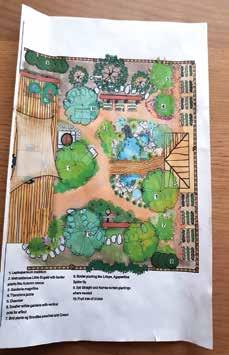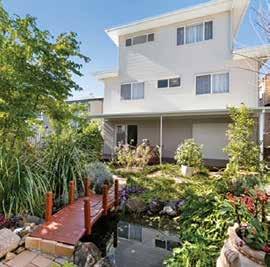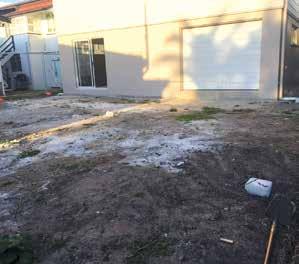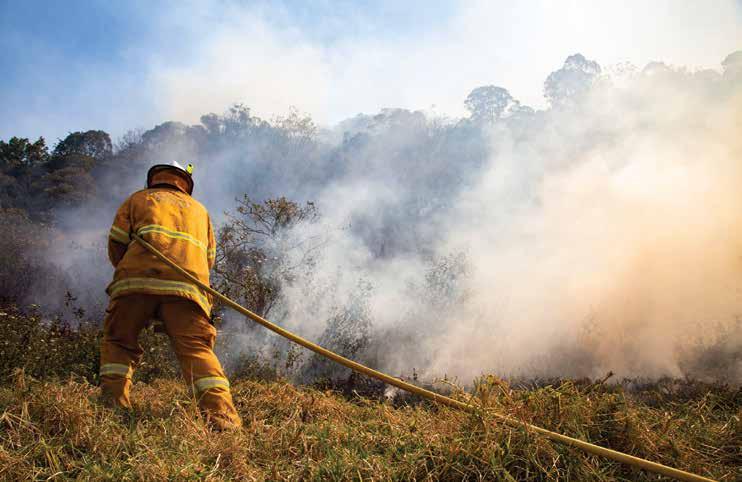
4 minute read
GARDENING TIPS AND TRICKS GARDENING TIPS AND TRICKS
BY Elena Telegina
With great interest, I read a page from Peter Schinkel about garden design. I can't agree more that the initial planning saves a lot of time and money down the road.
Advertisement


Photos: Queensland Fire and Emergency Services.
I completed a new garden project for my home in Redcliffe just recently. In three years, the garden went from just an empty building site filled with road base gravel to a lovely escape to spend days in. It also had fruit trees and veggies producing buckets for the table.


I was amazed myself how quickly the garden grew, so now I want to share a few tricks I used.
Watering system: I established the garden during the drought and water saving was a priority. Next to each tree or rose plant I dug in a 3 litres plastic milk bottle, pierced in a few holes. Then I connected all the bottles with water with underground hoses. Once a week I turned on the tap and filled the bottles with water. Slowly through the little holes, water went underground directly to the roots. I believe that saved me a lot of water compared to surface watering and kept the plant very happy. They were growing very fast. It saved a lot of time too, as no hose-held watering was required. Watering only took 10 min a week of my time.
Mulching: After I put plants in the ground and put the watering system in place, I covered the rest of the ground with cardboard to stop any weeds, and then covered the cardboard with 10 cm of garden mulch. The garden was only 10 m by 10 m, so it took about 1 truck of mulch from the landscape supplier. I never had to weed after that. Saved a lot of time for weeding.
Planting according to the moon:
As ancient gardeners always followed the moon cycles, so did I. I have a moon calendar and not just planting, but watering, pruning, and feeding all done according to suitable moon signs. It saved me a lot of money as the survival rate of the plants was high. They all were very happy with me.
I wonder if my experience can help other people at Bribie too. I recently moved to Bribie from Redcliffe and enjoy seeing a lot of wonderful gardens around. I became a part of B.I.E.P.A and hope to participate in the community garden program of this wonderful association.
It would be great to connect with like-minded people. Please join BIEPA and see me there.
RESIDENTS ARE BEING URGED TO GET READY FOR THE BUSHFIRE SEASON, WITH AN UPCOMING COMMUNITY INFORMATION SESSION BEING HELD BY QUEENSLAND FIRE AND EMERGENCY SERVICES AND MORETON BAY REGIONAL COUNCIL

PROVIDING
The information session for Bribie Island residents will be held on Thursday 30 March from 10am – 12noon at the Bribie Island RSL, Toorbul St, Bongaree. Rural Fire Service Bushfire Safety Officer Liane Henderson said the session would provide an important update on what to expect and how to get ready, as well as understanding bushfire warnings. “During the information session we will discuss the different warning levels, so everyone is aware of the actions they will need to take should a warning be issued for the area.
“We will also discuss the new Australian Fire Danger Ratings System and simple steps everyone can take to ensure their home is prepared for bushfire season.”


Preparing Soil for Tomatoes
Tomatoes are heavy feeders (much like hungry growing teenagers!). They will have a high need for nutrients throughout their growth cycle. As an annual crop, they are ‘takers’ and will leave the soil depleted. So, before planting you need to reinvigorate your soil. If you want lots of healthy fruit, strong roots and a good canopy of leaves to prevent sunburn, make sure to stock the soil pantry first. Good preparation is the key. Prepare your garden soil well. Add compost, rock minerals (also known as soft rock phosphate, rock dust or minerals) and mulch. If you have a worm farm, add vermicast (worm castings). Avoid high nitrogen fertilisers as you will get lots of leaves but few flowers and fruit!
If you don’t have compost, use some slow-release pelletised organic fertiliser with a balance of nutrients. Aim to compost your food scraps. It’s a sustainable practice to build healthy soil. Simply bury them in the garden bed before planting to enrich it and encourage worms.
Container Grown Tomatoes
If planting into a container, improve your potting mix to provide additional nutrients and moisture-holding ingredients. This prevents it drying out too quickly. Potted tomatoes need staying power! So, put the effort in and you’ll reap rich (and tasty) rewards. I find self-watering containers ideal for tomatoes. They provide you a buffer of time as they wick up moisture as needed. This can mean the difference between coming home to a ‘dried arrangement’ or a healthy plant!
Sowing Tomato Seeds
Tomato seeds need a warm soil between 18 – 28°C to germinate. If you sow too early or in very hot weather, high temperatures can delay germination or result in failure. Check the forecast first! Follow my Seed Starting Guide for success. Remember, sow seeds to save money and seedlings to save time.
Planting Tomato Seedlings
Seedlings will give you a head start on the growing season. Bury your tomato seedling or young plant deep (up the stem). This helps it establish a strong root system from day one. More roots, more shoots, flowers and fruit!
How does this work? Tomato stems have tiny bumps. So, by burying the stems deeper under the soil, adventitious roots form along the stem in addition to the main taproot. This additional root system allows a tomato plant to become more resilient to drought. Also, an extensive root system takes up more nutrients and soil moisture. So, when planting your seedling, bury it deep. Alternatively, lay it sideways in a shallow trench in your pot or garden bed. Leave the top leaves above the soil to photosynthesize.
Finally, you may need to gently stake the tender stem until it starts growing upwards again towards the light.
Feeding and Watering Tomatoes
• Maintain consistent moisture to avoid nutrient deficiencies, stress, pest attack, cracking or splitting of fruit and other problems.
• Avoid over-watering. This can result in split fruit.
• A compost-rich soil will hold sufficient moisture.
• Avoid high nitrogen fertilisers. Adding minerals to your compost or potting mix provides a balance of the macronutrients



